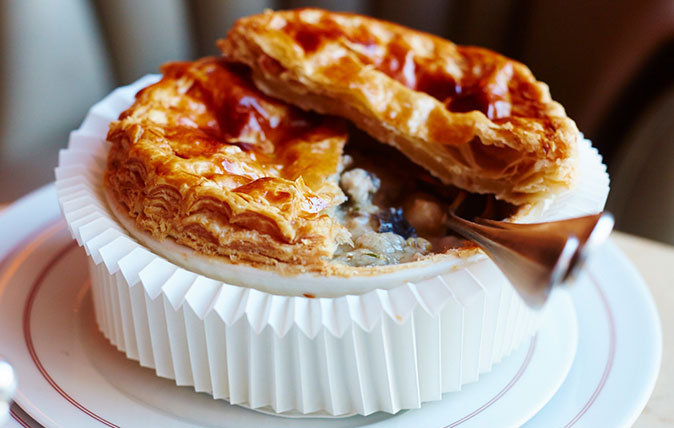Tom Parker Bowles on the classic English food that's 'never dull, comforting, and impossible to resist'
We defy you to Tom Parker Bowles's puddings piece and not hanker after a steak and kidney pudding. Thankfully, Tom also shares the late Gary Rhodes's recipe for exactly that.


Pudding Lane. Best known as the flashpoint for the Great Fire of London, but also one of those thoroughfares that beguile with the easy allure of their name. Imagine a stroll, sometime at the start of the 17th century, on a spring morning so crisp you could snap it in half and spread it with butter. Where, on your wander down towards the Thames, your nose is caressed by scents both sweet and savoury, from the blessed pudding makers who line your route. Certainly a seductive vision, but one without even a glimmer of truth.
Because ‘Pudding’ was another name for offal and the Lane used by Eastcheap butchers to transport their stinking carts of rotten innards—and meat scraps even the most dishonest pie man dare not use—down to the dirty, reeking dung ships that lurked on the dirty reeking shore. The stench, especially in summer, would have been unbearable. So much for the gentle charm of Pudding Lane.
Anyway, the word pudding derives from the Latin botellus, meaning sausage, via the old French boudin. In their original form, the concoctions were simply animal stomachs or innards stuffed with spiced meat, offal and oatmeal, then boiled until done. Like haggis, black pudding flavoured with blood or suet-flecked white. It was the invention of the pudding cloth, at about the start of the 17th century, that made large, boiled puddings possible, the cloth lined with a soft suet crust. The high melting point of that hard fat, found around the kidneys and loin of a cow, made the exterior the edible equivalent of Turner’s Study of Clouds. Cumulus light and breezily pretty.
And what a dish the savoury pudding is, mellow and beguiling, all voluptuous Titian curves. Simple, but never dull, comforting rather than stodgy, I find them impossible to resist, especially in their most famous form, steak and kidney, where rich liquor soaks deep into those snowy-white walls, and the whole thing can be eaten with a spoon. Accompanied, of course, by a bracing blob of English mustard. Yet these days, these puddings, like jellied consommé, are a rarity rather than a regular occurrence, only to be found in the likes of Rules or Piccadilly’s splendid new Devonshire.

It’s a crying shame, as, only a century or two back, they (together with suet dumplings) were an adored English staple, each county having their own speciality — Kentish chicken, Rutland rabbit, Northamptonshire Farmhouse, Essex Sea (beef and oysters), and Sussex pork and onion. Not forgetting the delightfully monikered Bedfordshire Clanger (meat at one end, jam at the other, so an entire lunch in one pudding), John Bull (beef and mushroom) and the Buckingham Bacon Badger. Grouse, pigeon and even pike were popular fillings.
Plain suet pudding, too, a Sunday-lunch farmhouse favourite, steamed, cut into cakes and put under the roast, to soak up all those juices. Quite why the savoury pudding has fallen out of favour, I don’t know. But comfort me with suet and I’m a very happy man.
Recipe: Steak and kidney pudding
Gary Rhodes was a great champion of British food. This recipe comes from New British Classics, which is itself a modern classic.
Exquisite houses, the beauty of Nature, and how to get the most from your life, straight to your inbox.
Ingredients
Serves 4-6
- 1–2tbspn beef dripping or cooking oil
- 450g chuck steak, cut into 2.5cm cubes
- 225g ox or lamb’s kidneys, cut into 2.5cm dice
- 2 carrots, cut into rough dice 1cm thick
- 2 onions, cut into rough dice 1cm thick
- 2 celery sticks, cut into rough dice 1cm thick
- 175g button mushrooms, quartered
- 300ml stout (optional)
- 600ml veal or beef stock
- 1 bay leaf
- 1 quantity suet pastry (make enough to line a 1.2 litre (2pt) pudding bowl)
- Salt and pepper
Method
Heat a frying pan with the dripping or oil and, in stages, fry the beef and kidneys, colouring well.
In a separate large saucepan, the carrots, onions, celery and mushrooms can all be fried in a touch of oil. Cook for a few minutes before adding the stout, if using. Bring to the boil and reduce by two-thirds. Add the stock and bring to the simmer. Add the bay leaf.
The beef and kidneys can now be added and brought to a gentle simmer. Cover and cook for 1–1½ hours until just becoming tender. It will finish its cooking during the steaming of the pudding. Adjust the seasoning with salt and pepper and leave to cool.
As the meat is cooking and cooling, the suet pastry can be made (I recommend following the recipe included in Rhodes’s book) and the pudding basin lined.
Once cool, the stewed beef and vegetables can be drained in a colander, reserving the cooking liquor. Remove the bay leaf, spoon the meat and vegetables into the pastry-lined basin and add just enough sauce to barely cover. This can now be topped with folded, buttered foil, wrapping it around as you would parchment paper, and twisting to hold. Stand in a steamer filled with hot water. This will now take about 1½ hours to cook the suet pastry and re-heat and finish the steak.
While the pudding is steaming, the remaining steak and kidney gravy can be brought to the simmer and strained through a sieve. This now gives you a gravy to pour over the turned-out pudding.
Remove the foil and turn the pudding out. Pour the sauce over and serve.

Credit: The Beaumont
Curious Questions: Why are we suckers for comfort food?
Shepherd’s pie, steak-and-kidney pudding, treacle sponge... these staples on the national menu are like old friends, lifting spirits in times

Credit: Getty
Recipe: How to make The Ivy's Shepherd's pie, perhaps the ultimate comfort food
The nights are drawing in, the weather is dreich and it's time for comfort food. That means that it's the
Tom Parker Bowles is food writer, critic and regular contributor to Country Life.
